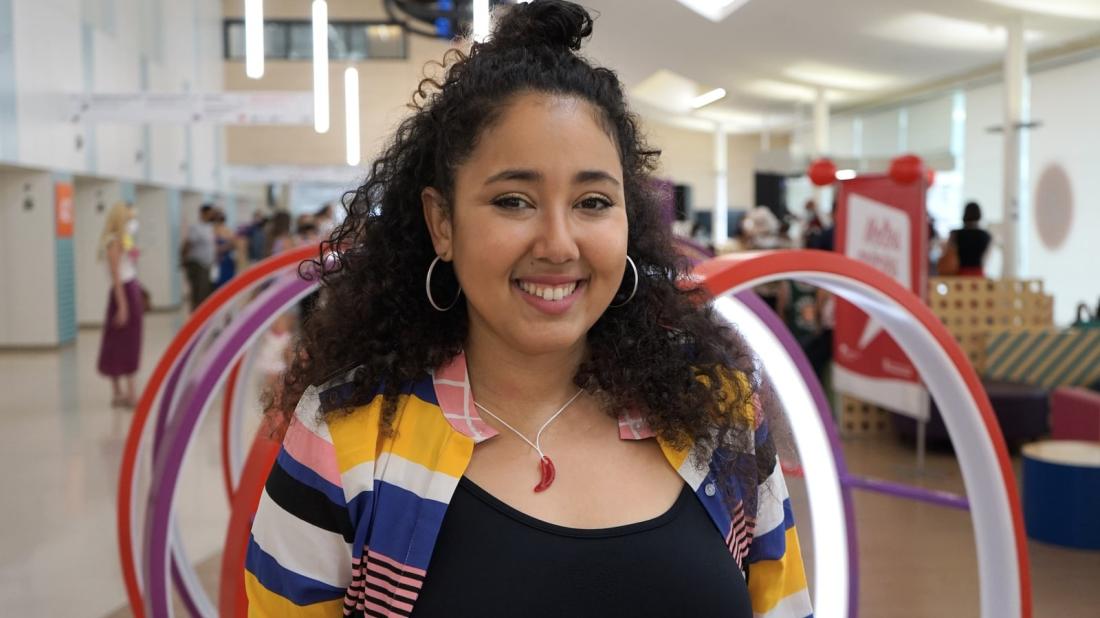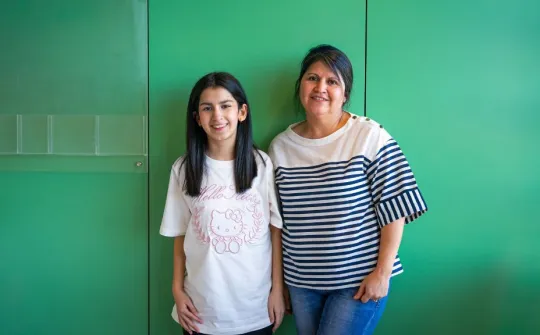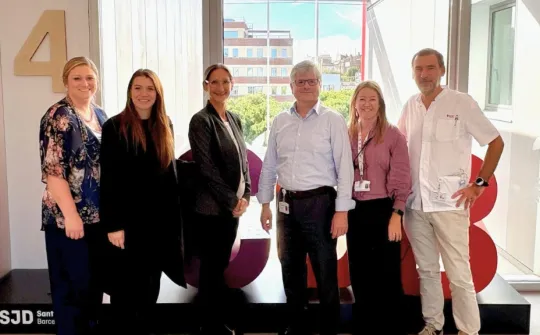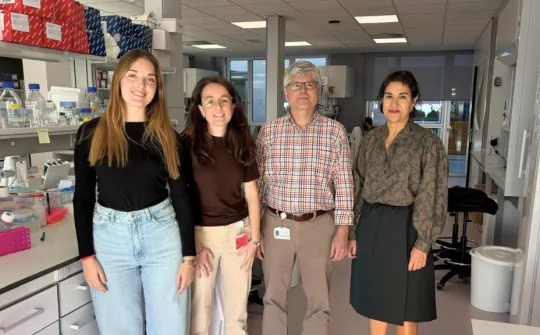“We should be doing research and providing tools to patients with sickle cell anemia from childhood”

Interview with Atenea, a former patient diagnosed with and treated for sickle cell anemia at the SJD Barcelona Children's Hospital.
Our interviewee today is a 31-year-old jazz singer and professional vocal coach. When Atenea was a baby, she started suffering from high fevers, so her mother brought her to the SJD Barcelona Children's Hospital. Here, after extensive tests, she was diagnosed with sickle cell anemia, a rare blood disorder.
This disease, known historically as drepanocytosis, is one of the most common genetic blood disorders in the world, affecting the red blood cells in blood plasma, which are the round-shaped cells that carry oxygen. In people with sickle cell anemia, these cells are crescent- or sickle-shaped, and get “stuck” in blood vessels, as they become more rigid and impede blood flow. When this happens, it is called a vaso-occlusive crisis, or hemolysis. These crises cause pain and can damage organs and tissues. Atenea recounts her personal experience at a workshop for pediatric patients and their families, and we took the opportunity to interview her.
How does it feel to meet with affected children and their families now as an adult?
It's emotional, for sure. I hugged Susana Rives, who was my doctor, and for me, it’s really healing being able to meet kids and their families because, a lot of the time, these patients, we feel invisible. Many people know what haemophilia is, for example, or what to do when someone is having a diabetic episode. Sickle cell anemia, however, is still quite unknown outside of here, the SJD Barcelona Children's Hospital, which handles all kinds of rare diseases. For me, the shocking difference between pediatric treatment and then moving to an adult hospital was that, a lot of the time, doctors just don’t know enough about what an episode, or a crisis, is. You end up having to push and explain things yourself (even when the crisis is really bad and you're in a lot of pain). For adults with this disease, we often have to specifically request to be seen by a hematologist and advise staff what can happen if we're not being properly attended to.
What is your relationship like with the hematology team at the SJD Barcelona Children's Hospital?
I was diagnosed here at two years old. I was treated at this hospital from then until I was twenty years old. My mother tells me that, years ago, doctor Estella (the then Head of the Haematology Department) gave her personal phone number so we had someone we could get in touch with about pain or crises when they happened. When I was around eight years old, the hospital team created a care protocol for patients with sickle cell anemia in the emergency department, which meant pain-relief was on-hand and immediate action could be taken. This isn't common practice in adult hospitals.
Over time, I've realised that the disease was treated here with the exact amount of importance that it actually has. One of the faculty members here at the SJD Barcelona Children's Hospital said in a patient information session that this is a “time-dependent” disease, because hemolysis, or a vaso-occlusive crisis, is very similar to thrombosis: it’s not the exact same because the blood doesn’t clot, but the red blood cells change shape and create blockages, so the effect is similar and you can’t waste any time. If this happens, there can be some very severe consequences of a crisis, such as bones being attacked and causing necrosis, or if it affects the cardiovascular system, you could have a stroke. You have to move quickly, and to make sure that happens, raising awareness and learning about the disease is vital.
It sounds nerve-wracking.
Because it is. There's still a lot of work ahead, and some associations are already making progress, because not all hospitals approach the disease like here. A lot of the time in the Emergency Department, during triage, nobody knows what's happening to you until a haematology specialist appears, as there isn't enough knowledge or protocols for adult patients. I'd say that receiving unnecessary treatment for my condition has been an ongoing factor. It just worsens the stigma and that feeling of not being understood.
This is a non-autochthonous disease that particularly affects patients with African origins, especially migrant families. In these cases, people don't only struggle with language or bureaucratic hurdles, but also problems within the healthcare system, as not enough is known about sickle cell anemia, despite it being one of the most common genetic disorders. I think there's definitely a racial bias that shouldn't exist, but it's unfortunately also present in the healthcare system. I myself have had to explain to family and friends what to do in an emergency situation.
And what should you do?
The crises are painful, so firstly, you need to keep calm and ask the person what they need. There is a degree of risk because of the temperature fluctuations, and if it's very warm, we need to cool down in the shade or a supermarket with air conditioning, for example, or somewhere similar. You shouldn't jump into water or do anything rash like that. There’s also a risk of an episode happening due to fatigue or anxiety, or changes in blood pressure. If the person suffering an episode complains of pain, which, as I mentioned, is severe, you should ask them whether they have any medication on hand to help ease their pain (morphine). If the person doesn't carry any medication, you should call 112 and explain what is happening to the person so the operator can tell you what to do next: if we need to go to the Emergency Department, wait for an ambulance, or what the quickest way to proceed is.
If whoever is helping the affected person is well informed, they'll be able to better explain the situation to the emergency care team. I've gone through a period of crises, and the people who have most helped me over the years, thanks to their extensive knowledge, are my mother and my partner. As I said, you often have to insist on being attended quickly in the Emergency Department. This is a recurring theme for the people who come to the association's sessions. These people have experienced many painful episodes and watched countless doctors pass them by in the waiting room, losing precious minutes of time.
Has your experience with the disease been different between childhood and adolescence and then as an adult?
Unfortunately, yes, it has. Paediatric patients are normally treated properly, but as you get older, the situation becomes more hostile. We need to raise awareness of the existence of this disease, as it's often confused with iron deficiency. It’s important that everyone with sickle cell anemia knows what to do, how to inform people of their situation and how to prevent a crisis. It's frustrating having to leave work when you’re in pain and you feel like your coworkers don’t understand what's going on until they see you with morphine.
We need to keep raising awareness about the importance of donating blood to help treat diseases like this. Adult Emergency Departments also need to get quicker when dealing with sickle cell anemia cases, and families should be put in touch so they can get to know one another and work together to make progress. For me, I try to raise awareness on my own, but it's a drop in the ocean compared to how much needs to be done.
Aside from raising awareness of sickle cell anemia, what else need to be done?
There are lots of things to do. In addition to what I've already mentioned, we need to be aware of side-effects. These can be more or less severe depending on what kind of sickle cell anemia a person has (if it comes from one or both parents). Some people suffer from debilitating pain during episodes, or they even have episodes that damage other parts of their body. In some cases, the disease can lead to fertility issues.
Research is key for sickle cell anemia, and so is providing tools to patients from a young age. It is essential to be in tune with your body so that when you're having a severe episode, you know how to identify it. The medication we take is called Hydroxyurea, which reduces the number of deformed red blood cells our body produces, in turn reducing the number of crises we have. As Susana Rives once explained it to me, if there are less deformed red blood cells, not only are there less crises, but also less need for blood transfusions and iron supplementation.
Finally, mental health is rarely spoken about in our community. It's really difficult being a teenager or young person with a disease like this, because you feel like you're the problem. You want to keep up with others and you feel social pressure to be part of the group. If you don't have the right tools, it’s easy to suffer both physically and mentally when you try to keep up with other people, and you end up unwell. Again, raising awareness of this would help a lot: not having to constantly explain your disease, especially when you suffer pain that is similar to having broken a bone, it's very much needed.



